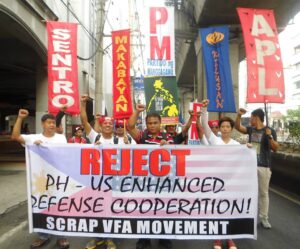Minds of the Movement
An ICNC blog on the people and power of civil resistance
by Charmaine WillisOctober 27, 2020
The September 2020 pardon of U.S. Marine Joseph Scott Pemberton for the killing of a young Filipina transgender woman, Jennifer Laude, served as a public reminder that a U.S. military presence remains in the Philippines years after the last actual U.S. base was closed in 1992.
Protests against the killing, led by local LGBTQ+ and women’s rights groups, erupted in the aftermath of both the original crime in 2014 and Pemberton’s recent pardon. This was the second known crime committed by a U.S. servicemember in the Philippines’ post-base era—the rape of a Filipina in 2005 was the first—and protests followed both incidents.
Nonviolent action against the U.S. military presence in the Philippines is not new, and this is perhaps unsurprising considering the Philippines’ colonial history (it was a U.S. territory from 1898 to 1946). After Filipino independence from the United States, the Americans supported President Ferdinand Marcos, who enacted martial law in 1972 purportedly to stem the spread of communism, ushering in an era of fear and violence. The 1980s and 1990s saw formidable anti-base protests, and they eventually succeeded at their goal of closing U.S. military bases in the country. However, a U.S. military presence remains—just in a more temporary and often invisible form, as per the 1999 Visiting Forces Agreement (VFA), detailed further below. Since then, the movements have had to shift their strategic course, notably, how to expose a more closeted injustice.
The Visiting Forces Agreement

The Scrap VFA! Movement calls for demilitarization of Asia during a rally held near the Malacanang Palace where U.S. President Barack Obama and President Benigno S. Aquino III met on April 28, 2014. Source: Yuen Abana via Scrap the VFA Facebook page.
The anti-base movements of the 1980s and early 1990s, framing the U.S. presence as a violation of Filipino sovereignty, pressured the Philippines Senate not to renew its basing agreement with the United States. The agreement was ultimately not renewed, leading to the closure of all U.S. military bases in the country in 1992.
However, a pivotal moment took place later in 1999, when the VFA went into effect. From then on, the U.S. military could, on a “temporary” basis, station troops at Philippines bases and conduct joint military exercises with the Armed Forces of the Philippines.
This aspect of the agreement presented a key challenge for the ability of the movement—by then called “Scrap the VFA!”—to mobilize widespread opposition to a renewed U.S. military presence. The lack of actual U.S. bases on Philippines soil made the U.S. military presence less visible and less likely to be the target of protest. In my research on the Philippines, for example, several people stated that the Philippines “kicked out” the U.S. military—that it was no longer there—despite the reality that troops were, and are, still present.
While the VFA did not become effective until 1999, the two governments convened the agreement and activists first took to the streets to oppose it in 1998. The U.S. and Filipino governments signed the VFA in January 1998, but the Philippines Senate had to ratify it for the agreement to be implemented. Several protests erupted mid-1998 as U.S. officials came to Manila to discuss the agreement.
Protests picked up in frequency in April and May 1999, as the Senate prepared to vote on the VFA. Protesters often gathered near the U.S. embassy or Philippines government buildings, shouting slogans like “junk the VFA!,” burning American flags, and forming giant human chains. Despite protesters’ efforts, the Senate voted to ratify the agreement at the end of May.
Military immunity, military impunity
Protesters raised several concerns about the VFA, including the safety of the communities that hosted U.S. troops and the lack of jurisdictional rights that the Philippines could exercise over crimes committed by military personnel. As activist Liza Maza stated, “That is what we are afraid about the VFA, in particular, the immunity clause, which will protect the interests of U.S. military forces only, but not their victims.” Activists were also concerned about the ambiguity of the agreement, as U.S. troops could be stationed at any of 22 possible locations, and local communities would likely not be made aware of the troops’ presence in advance.
Challenges and takeaways
The Scrap the VFA! Movement provides lessons for other nonviolent movements, particularly those with less visible or moving targets (such as financial corruption).
In a first instance, it is unclear how the Philippines government would terminate the VFA, which means that the movement may need to revisit their objectives and identify shorter-term goals such as gaining more Filipino jurisdictional rights in cases of crimes committed by U.S. troops—something for consideration by other activists worldwide.
Secondly, Filipino activists organized protests to coincide with scheduled events like visits from U.S. officials and important anniversaries (for example, the Philippines’ Independence Day). Accompanied by smart outreach planning, this type of approach increases visibility for a movement's actions.
Perhaps the most important takeaway, however, stems from the fact that the Filipino public largely overlooks the U.S. military’s presence. The injustice is less concrete now, so Filipino activists, and others in similar situations, may be wise to shift their efforts onto revealing the injustice. This means seizing certain moments—the Laude killing and pardon, in the Filipino case—to highlight persistent injustice and jump-start resistance. One related planning resource is Brian Martin’s Backfire Manual, which details how activists can react to perpetrators’ actions to channel public outrage and build support and empathy for their cause.
Incidents such as the Laude case serve as concrete manifestations of otherwise hidden injustice. Opportunities like this are most often unexpected, so activists must above all stay vigilant and be ready to organize nonviolent actions in order to react swiftly and effectively.

Charmaine Willis
Charmaine Willis is a Ph.D. candidate in the Department of Political Science at the University at Albany, State University of New York (USA). Her research primarily examines social movements, terrorism, and protest repression, with a regional focus on East Asia.
Read More